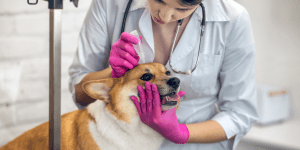Giving Medication To Dogs.
Administering medication to dogs can sometimes be a challenging proposition and often stressful for the dog. The old fashioned way of giving tablets was to force the dogs jaw open, push the tablet in and hold the muzzle shut, hoping that a few seconds later it doesn’t get spat, or drooled, out. There are more positive ways to approach the task of giving your dog tablets, or other forms of medication. This Holidays4Dogs article article provides a few tips and pointers on how to do this.
An uncooperative dog can make for an exasperating tussle, but it also creates a negative experience for the dog. It then makes it more difficult to repeat the process another time. This is particularly difficult for owners of dogs who need to be on regular medication. Read on for a few hints and tips to make giving medication to dogs a bit easier and stress free.
Giving tablets.
One of the easiest ways of making sure your dog takes tablets, is to have a few treats handy. Cheese is an excellent incentive, but you could use cooked liver, or small amounts of ham, equally well. Some people use softer treats like peanut butter. However, some dogs will just lick the treat from your fingers, leaving the tablet partially intact in your hands.
Gather a few treats together and push the tablet into one of the pieces of cheese. Then, give your dog a treat without the tablet.
If he is used to being rewarded for behaviours such as a sit, your dog will be more motivated to earn his treats and eat them quick. Pop the treat with the tablet into his mouth. Quickly follow with a couple more rewards.
If you do not have a food orientated dog, you could try crushing the tablet and mixing it with his food. However, you will need to check with your vet this is ok to do.
You could also try putting a whole tablet in your dog’s usual food. However, as dogs have such an excellent sense of smell they can become suspicious and refuse to eat anything that smells odd. Again, try and disguise the food with something really ‘smelly’ and tasty, such as grated cheese, liver, or sardines.
If all of this fails, you may have to resort to putting the tablet straight in to the dogs mouth. However, this really depends on how likely your dog is to struggle. If your dog becomes aggressive, or very fearful, you may need to ask your vet whether there may be an alternative medication, in liquid form.
Applying ear drops.
Giving ear drops can be just as challenging as giving oral medication to dogs. There may be a number of reasons why your dog needs ear drops, but ear mites are one of the more common.
There may be a number of reasons why your dog needs ear drops, but ear mites are one of the more common.
Lift the ear flap and direct the nozzle into the base of the ear. Drop the required amount into the ear then massage the ear to distribute the liquid. This is the part the dog should enjoy a little more!
If there is any excess fluid, wipe this away with a tissue and reward your dog with a treat. If your dog struggles, get a helper to offer the dog a treat tube, or other food that the dog can lick, while you administer the drops.
Applying eye drops.
Eye drops can also be tricky to administer to a wriggly dog. You may benefit from a helper that the dog knows well to assist in steadying his head. It is very important you do not accidentally poke the dog’s eye with the dropper itself! It might be an idea to get down to your dogs level. Avoid standing over him, or making him feel as if he is ‘trapped’.
If you have a small dog place him on a higher surface, using a towel for the dog to stand on, if it’s slippery. Gently part the eyelid with thumb and forefinger and apply the treatment to the pink part of the eyelid. The dog will immediately blink and it is a good idea to provide a few treats to distract the dog from shaking, or rubbing his face on clothing, or carpet.
At Holidays 4 Dogs we do not exclude dogs that are on medication, so owners who board their dogs with us can rest assured their dog’s daily medication routines are followed by experienced carers. Some of our trusted carers have specific veterinary nursing, or dog training, experience.
Giving medication to dogs need not be a tussle. It is always a good idea to get your dog used having his mouth, ears and face touched before you need to administer medication. It is usually not difficult to get your dog to accept this, through careful positive reinforcement training.


